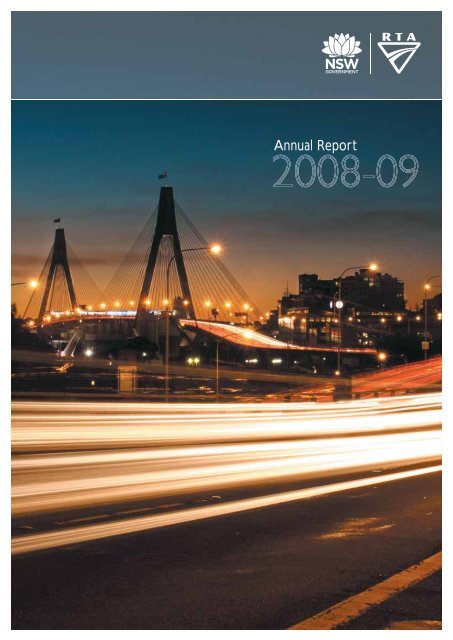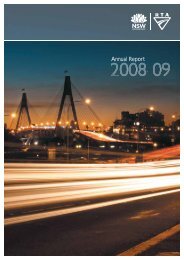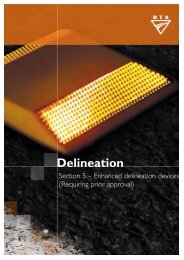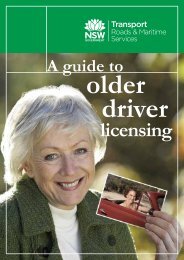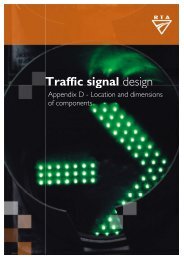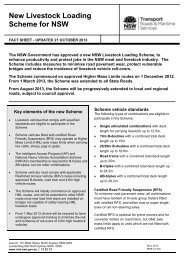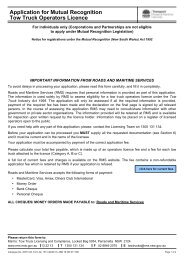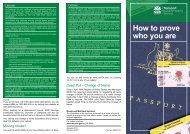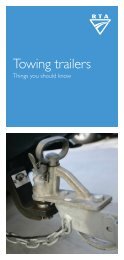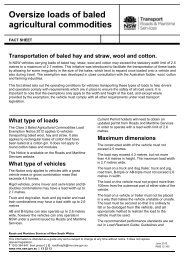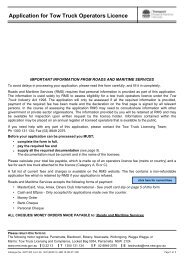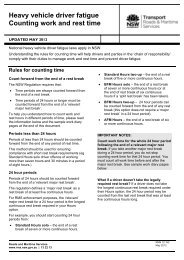RTA Annual Report 2009 Overview - RTA - NSW Government
RTA Annual Report 2009 Overview - RTA - NSW Government
RTA Annual Report 2009 Overview - RTA - NSW Government
You also want an ePaper? Increase the reach of your titles
YUMPU automatically turns print PDFs into web optimized ePapers that Google loves.
<strong>Annual</strong> <strong>Report</strong>
Vision<br />
Values<br />
A safe, sustainable and effi cient<br />
road transport system.<br />
The <strong>RTA</strong> has for so long been a leader in many fi elds, including road safety,<br />
customer service, engineering, maintenance, accounting and workforce<br />
development. Our values should refl ect this. That is why our values are:<br />
L learning – committed to improving our business through developing our<br />
staff and our technical and professional capabilities.<br />
E expertise – using our extensive experience to deliver quality results.<br />
A accountability – being fi nancially, environmentally and socially accountable.<br />
D dynamic – striving to be an organisation that is innovative in its approach to<br />
all business activities and adaptive to change.<br />
E equity – being open, honest, ethical and fair in all our dealings.<br />
R responsiveness – achieving effective results through fl exibility, effi ciency<br />
and continuous improvement.<br />
S safety – ensuring the community and our workforce are safe.<br />
LETTER TO THE MINISTER<br />
The Hon. David Campbell, MP<br />
Minister for Transport<br />
Minister for Illawarra<br />
Governor Macquarie Tower<br />
1 Farrer Place<br />
Sydney <strong>NSW</strong> 2000<br />
Dear Minister<br />
I have pleasure in submitting the <strong>Annual</strong><br />
<strong>Report</strong> and Financial Statements of<br />
the Roads and Traffi c Authority for<br />
presentation to the Parliament of New<br />
South Wales for the fi nancial year ended<br />
30 June <strong>2009</strong>. It has been prepared in<br />
accordance with the <strong>Annual</strong> <strong>Report</strong>s<br />
(Statutory Bodies) Act 1984 and the<br />
Public Finance and Audit Act 1983.<br />
Yours sincerely<br />
Michael Bushby | Chief Executive
Contents<br />
OVERVIEW 2<br />
Chief Executive’s overview 2<br />
<strong>RTA</strong> at a glance 4<br />
Performance overview 6<br />
Financial overview 9<br />
Organisational chart 11<br />
Executive profi les 12<br />
Corporate framework 14<br />
REVIEW OF OPERATIONS 17<br />
TRANSPORT 17<br />
The <strong>RTA</strong> manages the road transport system<br />
to provide reliable and effi cient movement of<br />
people and goods<br />
Development 18<br />
Alternative transport 29<br />
Traffi c 32<br />
ASSET 37<br />
The <strong>RTA</strong> works to maintain the road network<br />
and provide sustainable access for freight<br />
Access 38<br />
Maintenance 40<br />
SAFETY 47<br />
The <strong>RTA</strong> works to maximise the safety of the<br />
road environment, vehicles and road user behaviour<br />
Fatalities 48<br />
<strong>NSW</strong> Centre for Road Safety 49<br />
Safer roads 50<br />
Safer road users 52<br />
Safer vehicles 60<br />
ENVIRONMENT 65<br />
The <strong>RTA</strong> is working to minimise impacts<br />
on the natural, cultural and built environments<br />
Infrastructure 66<br />
Organisational 78<br />
Emissions 81<br />
SERVICES 83<br />
The <strong>RTA</strong> strives to meet the community’s needs<br />
Customer service 84<br />
Stakeholders 90<br />
GOVERNANCE 93<br />
The <strong>RTA</strong> ensures that its investment<br />
and its people are aligned to its vision<br />
Organisational governance 94<br />
Financial governance 101<br />
Our people 103<br />
FINANCIAL STATEMENTS 113<br />
Front cover image: Photo taken by<br />
<strong>RTA</strong> staff member Gabriel Denoury of<br />
traffi c exiting the Anzac Bridge at Pyrmont.<br />
This image: Photo taken by lightbox imageworks<br />
photographers, supplied by Northern Hume Alliance –<br />
Leighton Contractors Pty Ltd/Jackson Teece Architects,<br />
of the Tumbarumba Hume Highway Bridge.<br />
APPENDICES 197<br />
Compliance index 274<br />
INDEX 275<br />
CONTACT THE <strong>RTA</strong> 279
Chief Executive’s overview<br />
The <strong>RTA</strong> is an agency with many important responsibilities<br />
and the community expects concrete achievements from<br />
us. In 2008-09, I’m proud to report substantial successes<br />
in many areas, but in a report such as this we are always<br />
looking forward to the challenges of the future. These<br />
challenges are many and we have a plan to meet them<br />
– a corporate plan we’ve called Blueprint. This report is<br />
structured around the key result areas contained in Blueprint<br />
– transport, asset (the road network), safety, environment,<br />
services and governance. Following are the highlights of our<br />
performance in delivering results in these important areas<br />
in the past fi nancial year. Throughout the report, you’ll see a<br />
Blueprint symbol noting if a particular action has contributed<br />
to achieving a Blueprint outcome.<br />
Transport<br />
The transport task in <strong>NSW</strong> is immense and growing. The<br />
transport system is crucial to the economy as well as the<br />
daily lives of everyone in the community. This year the<br />
<strong>RTA</strong> managed the planning and construction of 82 major<br />
projects, with a total expenditure of almost $1.8 billion. Ten<br />
projects were opened to traffi c, including in Sydney and<br />
the regions. Upgrades of key regional roads such as the<br />
Pacifi c and the Hume highways continued at a steady pace<br />
– these projects are having great results in saving lives and<br />
improving travel times.<br />
In Sydney, the <strong>RTA</strong> manages traffi c through the Transport<br />
Management Centre using an array of technological tools<br />
and human know-how. Despite steadily increasing traffi c<br />
volumes, travel speeds on key major routes were unchanged<br />
for the afternoon peak period and actually increased slightly<br />
in the morning peak – a testament to the <strong>RTA</strong>’s careful<br />
management and planning.<br />
Asset<br />
As well as building new roads, the <strong>RTA</strong> has a huge job<br />
to ensure the road network is maintained to acceptable<br />
standards. In 2008-09, the <strong>RTA</strong> delivered a $1.089 billion<br />
infrastructure maintenance program – a signifi cant increase<br />
on the previous year. We built 10 replacement bridges and<br />
replaced, resealed or widened millions of square metres of<br />
road surface. Ride quality continued to trend upwards. Our<br />
approach focuses resources on critical maintenance activities<br />
and this will continue.<br />
Safety<br />
The past year was a record-breaking one for road safety in<br />
<strong>NSW</strong>. The 2008 calendar year was the sixth consecutive year<br />
in which the road toll decreased in <strong>NSW</strong> – the fi rst time this<br />
has happened since records began a century ago. The last<br />
time there were so few fatalities on our roads was 1944.<br />
While this reduction refl ects the excellent work of the<br />
<strong>RTA</strong>’s <strong>NSW</strong> Centre for Road Safety, and our effective ‘Safe<br />
System Approach’, there is no possibility that we will become<br />
complacent. In the fi rst six months of <strong>2009</strong>, provisional data<br />
indicated a marked increase in the road toll. The <strong>RTA</strong> will<br />
continue its multi-layered approach, working on programs<br />
that improve the safety of the road environment and<br />
support safer driving and safer vehicles. Innovation was again<br />
a feature of our work in road safety, from new point-to-point<br />
cameras to tackle heavy vehicle speeding, to the trial of the<br />
world-leading Intelligent Speed Adaptation technology which<br />
uses satellites to monitor and control speeding vehicles.<br />
Environment<br />
The <strong>RTA</strong>’s statutory responsibilities in relation to the<br />
environment are enormous (for example, in the past year<br />
we determined 247 review of environmental factors).<br />
However, we also work across numerous other areas to<br />
protect and enhance the environment. From reducing our<br />
own energy use and installing rainwater tanks at depots, to<br />
providing safe crossings of highways for threatened animal<br />
populations, the <strong>RTA</strong>’s environmental staff are making a<br />
real difference. Achievements in this area also include the<br />
less obvious – such as the discovery and preservation of a<br />
mid-19th century sandstone road in the Blue Mountains, or<br />
clever urban design to ensure new works fi t into the built<br />
and natural landscape.<br />
Services<br />
We continued to improve our motor registry network with<br />
a number of key registries being refurbished or relocated to<br />
more convenient and accessible locations. Our suite of tolling<br />
products was improved and expanded, with new short-term<br />
and Easy Toll tags proving popular with motorists. We have<br />
also progressed work to introduce new facial recognition<br />
technology to further protect the community against<br />
identity fraud.<br />
2 CHIEF EXECUTIVE’S OVERVIEW OVERVIEW
Governance and fi nancial management<br />
A rigorous governance framework is essential for an<br />
organisation as complex as the <strong>RTA</strong>. We continued to<br />
strengthen our corporate governance, improving our<br />
management systems to achieve sustained cost savings<br />
and refocusing business units to better deliver services<br />
and achieve outcomes. Occupational Health and Safety<br />
performance continued to be excellent, with the <strong>RTA</strong><br />
exceeding our target for reducing the workplace injury rate.<br />
Financial performance was also sound, with the effective<br />
management of our budget and maintenance of revenue<br />
levels, despite a very diffi cult economic environment.<br />
Our staff<br />
None of these achievements would be possible without the<br />
work of the <strong>RTA</strong>’s 7123 dedicated staff. Our workforce is<br />
skilled, passionate and focused, and I would like to thank all of<br />
them for their hard work in the past year.<br />
Michael Bushby<br />
Chief Executive<br />
‘‘<br />
The <strong>RTA</strong> is an agency with<br />
many important responsibilities<br />
and the community expects<br />
concrete achievements from<br />
us. In 2008-09, I’m proud to<br />
report substantial successes in<br />
many areas, but in a report such<br />
as this we are always looking<br />
forward to the challenges of<br />
the future. These challenges are<br />
many and we have a plan to<br />
meet them – a corporate plan<br />
we’ve called Blueprint.<br />
‘‘<br />
OVERVIEW CHIEF EXECUTIVE’S OVERVIEW 3
<strong>RTA</strong> at a glance<br />
Responsibilities<br />
The <strong>RTA</strong> is a <strong>NSW</strong> statutory authority that was established<br />
in 1989 under the Transport Administration Act 1988.<br />
The <strong>RTA</strong>’s primary responsibilities are to:<br />
• Manage the road network to reduce travel times.<br />
• Provide road capacity and maintenance solutions.<br />
• Test and license drivers and register and inspect vehicles.<br />
• Improve road safety.<br />
Activities<br />
The <strong>RTA</strong>’s activities are diverse and extensive.<br />
Key activities include:<br />
• Designing and constructing new roads and bridges and<br />
maintaining and enhancing road transport infrastructure.<br />
• Managing traffi c – a complex task which requires<br />
technological expertise, careful planning and the<br />
coordinated effort of engineers, planners and other staff.<br />
• Managing and regulating the road network, to ensure the<br />
respective needs of motorists, public transport, freight,<br />
commuters and pedestrians are balanced.<br />
• Implementing sustainable practices and environmental<br />
management to ensure the environmental impacts of<br />
construction, maintenance, road travel and congestion are<br />
managed, minimised and mitigated.<br />
• Taking a central role in road safety, including implementing a<br />
‘safe system’ approach to designing and managing the road<br />
network; encouraging safer driving through promotions,<br />
campaigns, testing and training; and working with the <strong>NSW</strong><br />
Police Force and using licensing and registration functions<br />
to enforce and support safer road user behaviour.<br />
Key dimensions<br />
Assets and funding<br />
The <strong>RTA</strong> manages a road network that includes:<br />
• 17,981km of <strong>RTA</strong>-managed State roads, including<br />
4269km of National Road Network, for which the<br />
Australian <strong>Government</strong> provides a funding contribution,<br />
and 163km of privately-funded toll roads.<br />
• 2946km of regional and local roads in the unincorporated<br />
area of <strong>NSW</strong>.<br />
• 5051 bridges, major culverts and 22 tunnels.<br />
• 3751 traffi c signals and other traffi c facilities, systems<br />
and corridor assets.<br />
The <strong>RTA</strong>’s non-road assets include:<br />
• 180 offi ces including 129 motor registries.<br />
• Purpose-built facilities including <strong>RTA</strong> Crashlab, the Transport<br />
Management Centre, Document Management Centre,<br />
Argyle Street offi ce building and the <strong>RTA</strong> Contact Centre.<br />
• Other facilities including work depots, motorcycle rider<br />
training centres, fl eet workshops, mobile service units,<br />
laboratories and inspection stations.<br />
The <strong>RTA</strong> holds road, bridge and traffic infrastructure with a<br />
written down value of $86 billion including land under roads. It<br />
also holds property, plant and equipment, private sector-provided<br />
infrastructure and other non-current assets with a written-down<br />
value of $4 billion. The <strong>RTA</strong> owns assets which are held for road<br />
projects including heritage-listed properties which are tenanted,<br />
maintained and managed by <strong>RTA</strong> property staff.<br />
The <strong>RTA</strong> Roads Program was $4.3 billion ($4,247 million)<br />
this year including contributions from the State and Australian<br />
governments, and revenue raised directly by the <strong>RTA</strong> from<br />
road user charges and other <strong>RTA</strong> generated revenue such as<br />
number plate sales, contributions to works from third parties,<br />
and sales of surplus properties.<br />
Licensing and registration<br />
In 2008-09 the <strong>RTA</strong> provided registration and licensing<br />
services to 4.72 million licence holders and 5.33 million<br />
registered vehicles in <strong>NSW</strong>. The <strong>RTA</strong> managed about<br />
20 million licensing and registration-related transactions in the<br />
past year. For more information on licensing and registration<br />
please see the Services chapter.<br />
Employees<br />
The <strong>RTA</strong> currently employs 7123 full time equivalent staff across<br />
<strong>NSW</strong>. About 48 per cent are employed in country locations, of<br />
which 30 per cent are wages staff and 70 per cent salaried.<br />
Given the diversity of the <strong>RTA</strong>’s activities, our staff work in a<br />
vast array of disciplines across many trades and professions.<br />
For more information on <strong>RTA</strong> staff please see the<br />
Governance chapter.<br />
Stakeholders and the community<br />
The <strong>RTA</strong> values its role in the community and undertakes<br />
signifi cant stakeholder consultation. Its external customers<br />
and stakeholders include motorists, commuters, pedestrians,<br />
private organisations, community and road transport<br />
groups, business groups, local councils and state and federal<br />
government agencies.<br />
4 <strong>RTA</strong> AT A GLANCE OVERVIEW
In 2008-09, local communities were involved in more<br />
than 250 different construction and maintenance projects.<br />
This involvement included community focus or liaison groups,<br />
community meetings, community display and information<br />
sessions, distribution of community updates and household<br />
letters, community events and regular meetings between<br />
<strong>RTA</strong> staff and individuals.<br />
The <strong>RTA</strong> participates in a wide range of signifi cant<br />
advisory groups and committees, as set out in Appendix 3.<br />
The <strong>RTA</strong> uses these and other avenues to remain informed<br />
about reports, reviews, impact statements and inquiries<br />
relevant to its operations and operating environment.<br />
The <strong>RTA</strong> liaises with the Australian <strong>Government</strong>, other state<br />
governments and local government across <strong>NSW</strong>.<br />
Strategic management framework<br />
The <strong>NSW</strong> State Plan has provided priorities to guide<br />
<strong>RTA</strong> actions as the lead <strong>NSW</strong> agency for safer roads. The<br />
strategic management framework (Figure 1) outlines the links<br />
between external drivers, internal planning and budgeting and<br />
delivery of outcomes. The <strong>RTA</strong> works within this framework<br />
to meet stakeholder priorities and expectations.<br />
FIGURE 1. <strong>RTA</strong> STRATEGIC MANAGEMENT FRAMEWORK<br />
Community<br />
Needs,<br />
Attitudes<br />
and<br />
Expectations<br />
State<br />
<strong>Government</strong><br />
Directions<br />
and<br />
Priorities<br />
National<br />
Directions<br />
and<br />
Priorities<br />
<strong>RTA</strong> Roads Program<br />
and Budget<br />
Blueprint<br />
<strong>RTA</strong> Corporate Plan<br />
<strong>RTA</strong> Results<br />
and Services Plan<br />
Total Asset Management<br />
Approach<br />
<strong>RTA</strong> Strategic plans,<br />
Business Plans and<br />
Resource Allocations<br />
SES Performance Agreements,<br />
Project and Individual<br />
Work Plans<br />
Output<br />
and<br />
Services<br />
Results<br />
About this report<br />
The annual report records the broad range<br />
of achievements of the <strong>RTA</strong> in the past<br />
financial year. Importantly, the annual report<br />
is also a tool of accountability, through which<br />
the community can track our performance<br />
throughout the year and examine details<br />
of projects that concern them.<br />
The report also provides a window on the internal management of the<br />
<strong>RTA</strong>, with details of our fi nancial arrangements, workforce management,<br />
community consultation programs and many other details.<br />
A performance summary at the beginning of the report is backed by<br />
detailed reporting on every area of the <strong>RTA</strong>’s operations. It has been<br />
colour coded to make it easy to navigate. A compliance index on page<br />
274 demonstrates how statutory reporting requirements have been met.<br />
This report includes many projects and other initiatives which have<br />
subsequently been completed and delivered. These post 30 June <strong>2009</strong><br />
events (such as road openings) will be included in next year’s report.<br />
OVERVIEW <strong>RTA</strong> AT A GLANCE 5
Performance overview<br />
Ongoing monitoring, assessment and reporting of performance indicators is a key component of the <strong>RTA</strong>’s performance<br />
management framework. A range of performance indicators are used to track progress, drive improvements in service delivery and<br />
assess result achievement. The <strong>RTA</strong> is committed to reporting a range of performance data in a variety of forms, such as the <strong>NSW</strong><br />
State Plan, Budget Paper 3 and Austroads’ National Performance Indicators.<br />
The following tables report <strong>RTA</strong> performance indicators against the key result areas of the corporate framework. The <strong>RTA</strong><br />
continually reviews its performance information and where indicators have been changed, the historical fi gures presented below<br />
have been amended for comparative purposes. The notes accompanying the tables provide detail on individual indicators.<br />
TABLE 1. TRANSPORT (SEE PAGES 17-36)<br />
Indicator 2005-06 2006-07 2007-08<br />
Target<br />
2008-09<br />
Actual<br />
2008-09<br />
Target<br />
<strong>2009</strong>-10<br />
Change in urban traffi c volume (% increase on previous year) 1.0 -0.2 0.8 0.5 0.1 0.5<br />
Travel speed: seven major routes AM peak (km/h, urban) 32 30 30 30 31 30<br />
Travel speed: seven major routes PM peak (km/h, urban) 42 41 43 41 43 41<br />
Bus lane length (km) 89 98 112 117 126 133<br />
Transit lane length (km) (i) (ii) 86 81 87 87 86 80<br />
Cycleway length (km)<br />
Off–road cycleways 1310 1395 1466 1509 1510 1557<br />
On–road cycleways 2380 2645 2742 2846 2795 2849<br />
(i) The reduction in transit lane length in 2008-09 is due to the upgrade of the transit lane on Windsor Rd to a bus lane.<br />
(ii) The reduction in transit lane length in the <strong>2009</strong>-10 target is due to the conversion of the M4 transit lane to general traffi c.<br />
TABLE 2. ASSET (SEE PAGES 37-46)<br />
Indicator 2005-06 2006-07 2007-08<br />
Target<br />
2008-09<br />
Actual<br />
2008-09<br />
Target<br />
<strong>2009</strong>-10<br />
Ride quality: smoothness of State Roads (% good/% poor) (iii) 87.5/4.6 87.9/4.4 88.6/4.2 89.0/4.1 89.1/3.9 89.0/4.0<br />
Pavement durability: cracking all State Roads (% good/% poor) (iii) 78.1/9.5 76.5/9.5 78.0/8.5 78.0/8.5 76.3/8.7 76.0/8.9<br />
Benefi t of development program ($ million) 2257 3041 4742 4612 # 4174 4610<br />
Major works completed within planned duration or within 10%<br />
over planned duration 82 75.3 95 90 92 90<br />
Number of bridges on State Roads at 30 June limiting legal usage<br />
due to structural condition 0 0 1 0 0 0<br />
Maintenance and reconstruction expenditure<br />
on State Roads per km of roadway ($000) (iv) 36 40 45 45 47 46<br />
(iii) An increase in maintenance funding in 2007-08 has resulted in improved ride quality and pavement durability results.<br />
(iv) Refl ects injection of funds into maintenance works in 2007-08 and 2008-09.<br />
# Target benefit of Development Program was revised in May 2008 to $4612 million (2008-09 State Budget Paper 3 – Volume 2, 20-11) based on 2008-09 allocations to projects.<br />
6 PERFORMANCE OVERVIEW OVERVIEW
TABLE 3. SAFETY (SEE PAGES 47-64)<br />
Indicator 2005-06 2006-07 2007-08<br />
Target<br />
2008-09 2008-09 (v)<br />
Fatalities/100,000 population (v) 7.9 6.4 5.4 N/A 6.2<br />
Fatalities/100 million vehicle km travelled (vi) 0.86 0.71 0.59 0.78 0.66<br />
% of fatalities where speed was a factor 38 37 35 N/A 41<br />
% of fatalities where illegal levels of alcohol was a factor (vii) 19 21 21 N/A 22<br />
% of vehicle occupant fatalities who were not wearing<br />
an available restraint 16 16 16 N/A 19<br />
% of fatalities where driver fatigue was a factor 19 19 17 N/A 16<br />
Motor vehicle controllers aged 25 years or under involved<br />
in fatal crashes per 10,000 licence holders (viii) 2.3 1.9 1.7 N/A 1.9<br />
Fatal crashes involving heavy trucks per 10,000 heavy trucks on register (viii) 7.6 7.4 7.0 N/A 6.4<br />
Heavy Vehicle Inspection Scheme: number of inspections 86,992 94,847 96,482 96,000 100,278<br />
Heavy Vehicle Inspection Scheme: percentage of defect free vehicles 50.76 51.00 56.00 52.00 56.37<br />
(v) Fatality and population fi gures for 2008-09 are provisional and subject to change.<br />
(vi) ABS travel estimates not yet published for <strong>2009</strong>. Fatality rates for 2008-09 have been calculated using projected estimated travel growth since 2008.<br />
(vii) 2008-09 alcohol data is incomplete at this stage due to the lag in processing alcohol blood samples and have been estimated.<br />
(viii) Licence holder and registration statistics are based on <strong>RTA</strong> data.<br />
TABLE 4. ENVIRONMENT (SEE PAGES 65-82)<br />
Indicator 2005-06 2006-07 2007-08<br />
Actual<br />
2008-09<br />
Target<br />
by 2011<br />
Number of environmental penalty infringement notices issued to the <strong>RTA</strong> 0 2 2 0 N/A<br />
Number of non-compliances with environmental<br />
protection licences held by the <strong>RTA</strong> (ix) 0 0 14 1 N/A<br />
Condition of heritage assets (% good) (x) 47 42.5 48 30 N/A<br />
<strong>RTA</strong>’s total greenhouse gas emissions from direct energy consumption<br />
(tonnes CO 2<br />
– e) (xi) (xii) 112,090 – N/A<br />
<strong>RTA</strong>’s total offi ce energy consumption (GJ) (target of 75,989 GJ) (xii) 73,203 80,032 72,361 – N/A<br />
<strong>RTA</strong> fl eet environment score (xiii) – passenger vehicle 10.4 10.7 12.3 12.55 13.5<br />
– commercial vehicle 7.4 7.9 8.0 8.48 9<br />
– Not yet available<br />
(ix) This indicator measures the number of non-compliances recorded with environment protection licenses held by the <strong>RTA</strong>. In 2007, a detailed compliance audit was<br />
undertaken which identifi ed a number of non-compliances. These are being rectifi ed and the forecast is expected to trend towards zero.<br />
(x) The 2006-07 condition of heritage assets was lower because condition was unable to be assessed for a number of heritage assets due to fl ooding at that time.<br />
(xi) Historical data has been amended due to changes in the Australian Greenhouse Offi ce method for converting energy use to greenhouse gas emissions.<br />
(xii) There is a 12 month lag in these fi gures.<br />
(xiii) These are Environmental Performance Scores (EPS) of all passenger vehicles and commercial vehicles in the <strong>RTA</strong> as at June <strong>2009</strong>.<br />
OVERVIEW PERFORMANCE OVERVIEW 7
TABLE 5. SERVICES (SEE PAGES 83-92)<br />
Indicator 2005-06 2006-07 2007-08<br />
Target<br />
2008-09<br />
Actual<br />
2008-09<br />
Target<br />
<strong>2009</strong>-10<br />
Use of <strong>RTA</strong> website (million visits) 11.35 13.97 16.45 N/A 21 N/A<br />
Customers rating service as ‘good or very good’ (%) 95 93 93 ≥ 90 94 ≥ 90<br />
TABLE 6. GOVERNANCE (SEE PAGES 93-112)<br />
Indicator 2005-06 2006-07 2007-08<br />
Target<br />
2008-09<br />
Actual<br />
2008-09<br />
Target<br />
<strong>2009</strong>-10<br />
Workplace injuries/100 employees (EFT) 7.0 6.4 6.1 5.6 4.9 5.1<br />
OHS liability workplace claims costs ($ million) (xv) 2.4 2.2 2.2 N/A 2.2 N/A<br />
Separation rate of staff (%) (xvi) 6.29 8.46 8.4 N/A 7.62 N/A<br />
(xv) Excludes journey and recess away claims (those occurring at lunch time away from the workplace). The liability target of $2.6 million is based on the Working Together<br />
pro rata target for 2006-07 of $6000 per claim and a reported result of 430 claims.<br />
(xvi) Separation rate is the proportion of staff that left the organisation. It includes salaried, wages and casual staff. The actual separation rate for 2005-06 was 9.92%.<br />
School Crossing Supervisors (accounting for 3.63% of the separations) were excluded from the annual separation fi gures resulting in an annual separation rate of 6.29%.<br />
8 PERFORMANCE OVERVIEW OVERVIEW
Financial overview<br />
Underpinning <strong>RTA</strong><br />
business delivery<br />
In 2008-09, a key focus for the <strong>RTA</strong>’s Finance and Performance<br />
Directorate was working in partnership with other business<br />
areas to ensure that program delivery and investment<br />
decisions were underpinned by solid fi nancial principles.<br />
This focus has been supported by the <strong>RTA</strong> Finance Strategy<br />
Committee which, in its governance role, has provided<br />
strong direction for the alignment and allocation of funding<br />
to strategic priorities, and review and evaluation of budget<br />
performance across all <strong>RTA</strong> programs.<br />
A number of initiatives also supported this approach, including:<br />
• Completion of a major upgrade of the Financial<br />
Information Management System in November 2008.<br />
• The enhancement of specialist fi nancial support to the<br />
<strong>RTA</strong> through the establishment of the Corporate Finance<br />
Strategy and Commercial Strategy Development teams,<br />
both of which directly contribute to the delivery of the<br />
<strong>RTA</strong> corporate plan.<br />
• Partnerships between the Corporate Finance Strategy<br />
team and directorates to provide high level fi scal and<br />
economic leadership. This allows the <strong>RTA</strong> to optimise the<br />
benefi ts of public/private partnership road infrastructure<br />
projects and deliver sustainable revenue streams to<br />
contribute to the <strong>RTA</strong> roads program.<br />
• Work of the specialist Commercial Strategy and<br />
Development team across the <strong>RTA</strong> to drive a commercial<br />
approach to management of businesses and identify and<br />
develop commercial opportunities to contribute to the<br />
funding of core <strong>RTA</strong> programs.<br />
• Development of a dedicated management system<br />
to track the fi nancial aspects of all public/private<br />
partnerships arrangements over the full span of<br />
each contract.<br />
Financial performance<br />
Quantitative examples of the <strong>RTA</strong>’s effective fi nancial<br />
management include:<br />
• Management of its $4.3 billion funding and<br />
expenditure program.<br />
• Generation of $64.3 million gross revenue from the sale<br />
of surplus property and leasing of residual property.<br />
• Maintenance of revenue levels for the sales of general<br />
goods and services in a diffi cult economic climate.<br />
• Management of property information relating to<br />
$3.0 billion of property assets.<br />
Detailed fi nancial results are shown in the Financial<br />
Statements section (see page 113).<br />
OVERVIEW FINANCIAL OVERVIEW 9
Expenditure<br />
Operating expenditure for the year was $2.933 billion (up from $2.691 billion in 2007-08). Expenditure on capital works was<br />
$2.262 billion (up from $2.065 billion in 2007-08). In achieving this result the <strong>RTA</strong> met government commitments to initiatives<br />
including the continuation of the Pacifi c Highway upgrade, the Hume Highway upgrade, railway level crossing upgrades and<br />
pavement surfacing and replacement issues identifi ed by the Auditor-General in his report ‘Condition of State Roads’.<br />
FIGURE 2. OPERATING EXPENDITURE 2008-09 $2.933 BILLION<br />
Road development $13 million<br />
Debt servicing $103 million<br />
Road management $2.208 billion<br />
Road user $497 million<br />
M4/M5 cashback scheme $108 million<br />
Voluntary redundancy $4 million<br />
Revenue<br />
In 2008-09 the State <strong>Government</strong> provided $2.539 billion or 59 per cent of the revenue received. This compared to<br />
$2.419 billion in 2007-08.<br />
The Australian <strong>Government</strong> contributed $1.184 billion, 47 per cent towards the Auslink Network and non-network projects, 45 per<br />
cent towards the Pacifi c Highway Accelerated Program, and the rest for the Australian Transport Safety Bureau Blackspot Program,<br />
Kings Highway, Strategic Regional Programs and Interstate Registration Scheme. This compared to $783 million in 2007-08.<br />
Additional funding for the <strong>RTA</strong> roads program was achieved through <strong>RTA</strong>-sourced revenue of $557 million. <strong>RTA</strong>-sourced<br />
revenue in 2007-08 was $700 million, that included a one-off grant of $144 million from the Queensland <strong>Government</strong> for the<br />
Tugun Bypass.<br />
FIGURE 3. REVENUE 2008-09<br />
<strong>RTA</strong> revenue $557 million<br />
M4/M5 cashback (State) $108 million<br />
Motor vehicle taxes (State) $1.231 billion<br />
Consolidated fund allocation $1.200 billion<br />
Commonwealth $1.184 billion<br />
10 FINANCIAL OVERVIEW OVERVIEW
Organisational chart<br />
The <strong>RTA</strong> is made up of seven directorates supported by the Environment branch, Governance branch and General Counsel that<br />
work closely together to achieve results in all key areas. These business areas and their key tasks are outlined below.<br />
CHIEF EXECUTIVE<br />
Delivery of corporate vision and results in support of <strong>NSW</strong> <strong>Government</strong> priorities.<br />
• Organisational management<br />
and improvement.<br />
• Inter-agency planning and delivery.<br />
• Network development and management.<br />
• Road safety.<br />
• Service delivery to road users.<br />
DIRECTOR ROAD SAFETY<br />
• Road safety strategy, policy, legislation<br />
and guidelines.<br />
• Road safety in road design, construction,<br />
maintenance and operation.<br />
• Improve positive road user behaviour.<br />
• Road safety in vehicle design, construction<br />
and maintenance.<br />
• Road safety research.<br />
• Road safety related data, evidence and advice.<br />
• Emerging road safety technology.<br />
DIRECTOR LICENSING,<br />
REGISTRATION & FREIGHT<br />
• Legislation and regulation development<br />
and compliance.<br />
• Individual and industry compliance and<br />
enforcement, including heavy vehicles,<br />
tow trucks and auto trade sectors.<br />
• Assessment, licensing and education<br />
of drivers and riders.<br />
• Assessment and registration of vehicles.<br />
• Customer services and products.<br />
• Identity management processes.<br />
• Freight policy.<br />
• Reduction of vehicle emissions.<br />
• Sanctions and prosecutions management.<br />
• National transport reform.<br />
• Tolling operations.<br />
DIRECTOR NETWORK<br />
MANAGEMENT<br />
• Network planning.<br />
• Road Network Investment Strategy.<br />
• Travel demand management.<br />
• Maintenance and enhancement.<br />
• Motorway management.<br />
• Traffi c systems.<br />
• Traffi c facilities asset management<br />
• Incident and event management.<br />
• Tolling facilities and processes.<br />
• Bus priority initiatives on strategic corridors.<br />
• Pedestrian and cyclist facilities.<br />
• Railway level crossing enhancements.<br />
• Road use information.<br />
• Road environment safety program.<br />
• Operational performance of the road network.<br />
DIRECTOR MAJOR<br />
INFRASTRUCTURE<br />
• Managing the Road Development Program.<br />
• Project management services and contract<br />
administration.<br />
• Acting as the Principal for infrastructure projects.<br />
• Promoting best practice in project and<br />
contract management.<br />
• Managing <strong>RTA</strong>’s strategy and policy for<br />
infrastructure contracts.<br />
• Managing tendering processes, property acquisition<br />
and the design and construction of motorways,<br />
and providing expert advice on tunnel technology.<br />
• Managing the upgrading of the Pacifi c and<br />
Hume Highways.<br />
• Managing the community involvement and<br />
communications process for infrastructure<br />
planning, development and maintenance.<br />
DIRECTOR REGIONAL OPERATIONS<br />
& ENGINEERING SERVICES<br />
• Regional construction and maintenance program.<br />
• Regional asset and network management.<br />
• Integrated delivery of network enhancement,<br />
network maintenance, road safety and traffi c<br />
management programs.<br />
• Specialist engineering and technical advice.<br />
• Bridge engineering.<br />
• Road design.<br />
• Pavements and geotechnical engineering.<br />
• Intelligent transport systems.<br />
• Surveys.<br />
• Road and fl eet services.<br />
DIRECTOR FINANCE &<br />
PERFORMANCE<br />
• Monitoring and evaluating fi nancial performance<br />
in all key areas.<br />
• Provision of high-level fi nancial and commercial<br />
advice to support strategic business<br />
decision-making.<br />
• Leading improvements in budgeting and<br />
investment decision-making.<br />
• Ensuring fi nancial and commercial discipline in<br />
the utilisation of the <strong>RTA</strong>’s real estate portfolio.<br />
• Strategic management of risk exposures.<br />
• Contributing to effective management of<br />
<strong>RTA</strong> assets and fi nancial resources.<br />
• <strong>RTA</strong> wide service support.<br />
• Corporate planning and driving<br />
organisational performances.<br />
DIRECTOR CORPORATE<br />
SERVICES<br />
• Healthy and safe workplace.<br />
• Leadership and workforce<br />
capability management.<br />
• Communication and education.<br />
• Industrial relations.<br />
• Community liaison consultation<br />
and inquiries.<br />
• Internal communication.<br />
• Information technology.<br />
• Freedom of Information, privacy<br />
and contract reporting.<br />
• Marketing and media.<br />
• Ministerial correspondence.<br />
GENERAL MANAGER<br />
ENVIRONMENT<br />
• Environment policies,<br />
procedures and advice.<br />
• Management of<br />
environmental risks.<br />
• Environment and heritage<br />
asset management.<br />
• Review environmental outcomes<br />
for project planning and delivery.<br />
• Contribute to government<br />
environmental objectives.<br />
GENERAL COUNSEL<br />
LEGAL BRANCH<br />
• Legal representation.<br />
• Legal strategy, policy<br />
and advice.<br />
• Specialist legal services.<br />
• Legal risk framework<br />
development.<br />
GENERAL MANAGER,<br />
GOVERNANCE<br />
• Governance.<br />
• Risk Management.<br />
• Audit / Assurance.<br />
• Fraud and Corruption Prevention.<br />
• Fraud and Corruption<br />
Investigations.<br />
OVERVIEW ORGANISATIONAL CHART 11
Executive profi les<br />
As at 30 June <strong>2009</strong><br />
Michael Bushby | Chief Executive<br />
BE, BBus, MEng (Project and Construction Management), FAICD, MIE (Aust)<br />
Michael has nearly 30 years’ career experience, with a focus on managing state road networks in<br />
Tasmania and New South Wales. He was responsible for Tasmania’s state road network before moving<br />
to <strong>NSW</strong> in 1998 to take up the role of General Manager, Infrastructure Maintenance, at the <strong>RTA</strong>.<br />
Michael has for periods held the roles of Director, Road Safety, Licensing and Vehicle Management<br />
and Director, Network Management. After a period acting in the role, Michael was appointed<br />
Chief Executive of the <strong>RTA</strong> in July <strong>2009</strong>.<br />
Peter Collins | A/Director, Network Management<br />
BE (Civil)<br />
Peter has more than 38 years’ experience with the <strong>RTA</strong>. He has progressed through the engineering<br />
ranks since beginning as an <strong>RTA</strong> cadet and has held positions all over the State including Regional<br />
Manager, Northern Region. Peter has worked on a range of major road projects including the<br />
upgrade of the Pacifi c Highway. From 16 February this year, Peter assumed responsibility for<br />
leading the planning, management and maintenance of the road network as Acting Director of<br />
the Network Management Directorate. His substantive role is Director Regional Operations and<br />
Engineering Services.<br />
Paul Hesford | Director, Finance and Performance<br />
BSc(Hons),CA (ICAEW)<br />
Paul Hesford was appointed to his current position in July 2008 after working in various roles for<br />
the <strong>RTA</strong> since 2005. Previously, he was the Group Financial Controller in the Asia Pacifi c Region for<br />
a US group. He has been Senior Manager for Audit for KPMG in its Darwin offi ce and was Financial<br />
Controller for the government-owned Power and Water Authority. Before moving to Australia,<br />
Paul was a Chartered Accountant at KPMG in Britain.<br />
Ann King | Director, Licensing Registration and Freight<br />
Ann has more than 25 years’ experience in customer-focused senior executive roles in both the public<br />
and private sector. Before joining the <strong>RTA</strong>, Ann held a number of director and senior management<br />
roles with companies including Nokia, Vodafone and NIB. Leading over 1600 people, Ann’s various<br />
responsibilities include licensing and educating the State’s 4.72 million licence holders, managing State<br />
and national freight programs, managing compliance and enforcement programs, regulating the heavy<br />
vehicle and tow truck industries and leading various environmental initiatives. Ann has also designed<br />
industry award winning customer service offerings within the <strong>RTA</strong>’s contact centre, property and<br />
e-business disciplines.<br />
Rod Tout | Director, Corporate Services<br />
Dip.Pub.Admin, BBus, MAdminLaw & Policy, Fellow AIM<br />
Rod has worked in seven government organisations at State and Commonwealth level, including<br />
a central government agency, the federal courts, commercialised business and direct public<br />
service-delivery agencies. Rod manages a range of services including human resources, technology,<br />
communications, health and safety and ministerial correspondence.<br />
12 EXECUTIVE PROFILES OVERVIEW
Dr Soames Job | Director, Centre for Road Safety<br />
PhD (psychology), BA (fi rst class honours in Psychology)<br />
Soames has more than 25 years’ experience in program management, delivery, research, policy analysis<br />
and development in road safety. Soames was a key player in the introduction of random breath testing<br />
to <strong>NSW</strong> in his former position as Head of the then Alcohol and Drug Division of the Traffi c Accident<br />
Centre. Soames has led the implementation of the <strong>RTA</strong> Safe Systems Partnership approach to road<br />
safety and is listed in Who’s Who in the World, Who’s Who in Science and Technology, Who’s Who in Health<br />
and Medicine, and the Cambridge International Biographical Centre’s 2000 Outstanding People of the<br />
20th Century for his work in road safety and health psychology. Soames’ scientifi c publications include<br />
four books, 17 book chapters, more than 360 scientifi c papers and more than 260 conference papers.<br />
Mike Veysey | A/Director, Regional Operations and Engineering Services<br />
BE, MEngSc, Dip LR & Law<br />
Mike has more than 30 years’ experience in State and local government and has held a number of<br />
senior executive positions in the <strong>RTA</strong> including General Manager, Technology Strategy, and Regional<br />
Manager, Sydney. Mike is responsible for regional asset and network management and delivering<br />
regional construction and maintenance programs. He is also responsible for providing specialist<br />
engineering and technical support across the <strong>RTA</strong>.<br />
Brian Watters | Director, Major Infrastructure<br />
BSc (Civil), MEngSc (Transport), Dip TCP<br />
Brian has more than 35 years’ experience in transport planning, infrastructure development and program<br />
management. He has been involved in the planning of most major road projects in <strong>NSW</strong> over the past<br />
24 years, and has worked closely with other government agencies. Notable projects have included the<br />
planning and procurement of the Sydney Harbour Tunnel as <strong>NSW</strong>’s fi rst Public Private Partnership and<br />
planning of the Eastern Distributor, M5 and Westlink M7 motorways and the Lane Cove Tunnel.<br />
Erica Adamson | General Manager, Environment<br />
BSc, MSc (Hons), LLB<br />
Erica has extensive environmental management experience in the private and government sectors,<br />
including planning, assessment and delivery of some of Sydney’s largest transport infrastructure<br />
projects – the Airport Railway Line, Chatswood to Epping Railway and the Lane Cove Tunnel. Erica<br />
has responsibility for environmental direction, policy and performance improvement across <strong>RTA</strong>.<br />
Rob McCarthy | General Manager, Governance Branch<br />
ACA<br />
Rob is a Chartered Accountant with more than 35 years’ experience in the accounting profession,<br />
banking and the <strong>RTA</strong>. Before joining the <strong>RTA</strong>, he held a range of senior executive positions. He has<br />
been responsible for a number of major projects including the conversion of a building society to<br />
a trading bank, the start of a life insurance company and the implementation of a risk management<br />
process across the <strong>RTA</strong>.<br />
As at 30 June <strong>2009</strong> the Legal Counsel position was vacant.<br />
OVERVIEW EXECUTIVE PROFILES 13
Corporate framework<br />
Community results<br />
<strong>NSW</strong> STATE PLAN<br />
THEMES<br />
Growing prosperity across <strong>NSW</strong><br />
<strong>RTA</strong> VISION<br />
A safe, sustainable and efficient road transport system<br />
<strong>RTA</strong> RESULTS<br />
Transport<br />
The road transport system supports reliable and<br />
effi cient movement of people and goods<br />
PAGE 17 PAGE 37<br />
Asset<br />
The condition and value of the road<br />
network meets acceptable standards<br />
INTERMEDIATE<br />
RESULTS<br />
Development<br />
Network development<br />
meets future growth,<br />
populations and<br />
freight needs<br />
Alternatives<br />
Alternative forms<br />
of transport are<br />
supported<br />
Traffic<br />
People and freight<br />
movement and<br />
incident management<br />
are optimised<br />
Access<br />
Heavy vehicle access to the<br />
road network<br />
is sustainable<br />
Maintenance<br />
The road network has<br />
been maintained to<br />
the required condition<br />
and value<br />
Business results<br />
<strong>NSW</strong> STATE PLAN<br />
THEMES<br />
Delivering better services<br />
<strong>RTA</strong> VALUES<br />
Values<br />
Learning – Expertise – Accountability – Dynamic – Equity – Responsiveness – Safety<br />
<strong>RTA</strong> RESULTS<br />
Services<br />
Meeting community needs<br />
PAGE 83<br />
INTERMEDIATE<br />
RESULTS<br />
Customers<br />
High quality:<br />
• Service delivery<br />
• Data integrity<br />
• Identity management<br />
• Accessibility<br />
Stakeholders<br />
Effective:<br />
• Consultation<br />
• Communication<br />
• Partnerships<br />
• Leadership in policy<br />
14 CORPORATE FRAMEWORK OVERVIEW
Delivering better services<br />
Environment for living<br />
Safety<br />
The safety of the road environment, vehicles<br />
and road user behavior is maximised<br />
PAGE 47 PAGE 65<br />
Environment<br />
Impacts on the natural, cultural and built environments<br />
are minimised<br />
Roads<br />
Vehicles<br />
Users<br />
Infrastructure<br />
Organisational<br />
Emissions<br />
The safety of the<br />
road environment<br />
is maximised<br />
The safety<br />
of vehicles is<br />
maximised<br />
The safety of road<br />
user behavior is<br />
maximised<br />
The impact of roadworks<br />
on the environment is<br />
minimised and positive urban<br />
design outcomes produced<br />
Use less resources,<br />
reduce waste and<br />
reduce our footprint<br />
Contribute to<br />
a reduction in<br />
vehicle emissions<br />
Fairness and opportunity<br />
Governance<br />
Aligning our investment and people to our vision<br />
PAGE 93<br />
Financial<br />
Advanced:<br />
• Business opportunities<br />
• Accountability<br />
• Financial performance<br />
Organisational<br />
High quality:<br />
• Planning and risk management<br />
• Performance management<br />
• Operational and information systems<br />
• <strong>Report</strong>ing framework<br />
Our people<br />
Delivering:<br />
• High performance culture<br />
• Workforce capability<br />
• Diversity and equity<br />
• Occupational Health and Safety (OHS)<br />
OVERVIEW CORPORATE FRAMEWORK 15
Corporate framework<br />
The <strong>RTA</strong>’s corporate framework, which forms the basis of<br />
this report’s structure, expresses the alignment between<br />
government priorities, and the <strong>RTA</strong>’s vision, values and result<br />
areas. The framework clearly sets out the results that the<br />
<strong>RTA</strong> is working towards. The framework provides a basis<br />
for integrated performance reporting that is aligned with<br />
business plans, the corporate plan and key result areas. The<br />
framework is consistent with <strong>NSW</strong> Treasury’s results and<br />
services planning and reporting requirements.<br />
Sustainability principles are recognised in the framework’s<br />
inclusion of economic, social, and environmental results.<br />
The framework enhances the shared responsibility principle<br />
where <strong>NSW</strong> <strong>Government</strong> agencies work in partnerships<br />
with other government agencies, local councils, the private<br />
sector and other stakeholders to achieve outcomes.<br />
The framework is a tool used to demonstrate the<br />
contribution the <strong>RTA</strong> makes to the <strong>NSW</strong> State Plan and<br />
other government priorities and ensures that its strategies<br />
are transparent, accountable and fi scally responsible.<br />
Corporate plan – Blueprint<br />
The <strong>RTA</strong> corporate plan, Blueprint, sets the priorities and<br />
milestones for the short term. The Blueprint agenda does<br />
not cover all aspects of the <strong>RTA</strong>’s operations, but clearly<br />
demonstrates our areas of focus. These are the tasks the<br />
organisation has set itself to achieve:<br />
• Managing Sydney roads.<br />
• Managing rural and regional roads.<br />
• Transporting freight.<br />
• Improving maintenance.<br />
• Advancing business opportunities.<br />
• Improving road safety.<br />
• Improving services.<br />
• Developing careers.<br />
• The Green Plan.<br />
To ensure a focus on the implementation of the <strong>RTA</strong> Blueprint<br />
within the broad scope of the <strong>RTA</strong>’s responsibilities, the <strong>RTA</strong><br />
Blueprint commitments have been integrated into existing <strong>RTA</strong><br />
business planning and monitoring mechanisms.<br />
The following icon is used throughout this report<br />
to highlight where signifi cant work has progressed<br />
on an <strong>RTA</strong> Blueprint related activity.<br />
The <strong>RTA</strong> continues the commitment to delivering the<br />
Blueprint through a focus on the corporate framework and<br />
agenda items.<br />
Blueprint is aligned with the <strong>NSW</strong><br />
State Plan, clearly outlines the corporate<br />
framework and provides the direction for<br />
the <strong>RTA</strong> over the coming years to achieve<br />
its results and deliver its services.<br />
Blueprint drives the organisational planning<br />
and performance management processes.<br />
Blueprint can be viewed in full at www.rta.nsw.gov.au<br />
16 CORPORATE FRAMEWORK OVERVIEW


